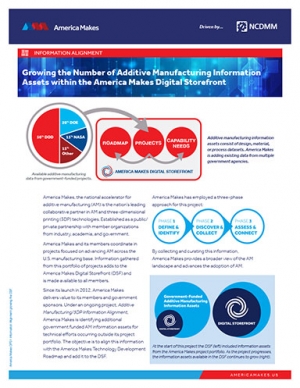America Makes Announces Awardees of Project on Advanced Tools for Rapid Qualification
Awarded project teams to develop and deploy innovative, cost-effective, and energy-efficient AM technologies for defense and commercial needs.
Latest News
May 17, 2019
America Makes announces five awardees of its directed project opportunity for Advanced Tools for Rapid Qualification (ATRQ) funded by the Department of Defense (DoD), Office of the Secretary of Defense, Manufacturing and Industrial Base Policy Office (OSD/MIBP) through the Air Force Research Laboratory (AFRL). The ATRQ Directed Project Opportunity seeks to promote and accelerate the development and deployment of innovative, cost effective and energy-efficient AM technologies with the objective of meeting defense and/or commercial needs.
Driven by the National Center for Defense Manufacturing and Machining (NCDMM), America Makes and OSD/AFRL are targeting to make available approximately $3.9M to fund multiple awards with at least $1.95M in matching funds from the awarded project teams for total funding worth roughly $5.9M.
“The DoD’s need for rapid qualification and certification of AM processes and materials is great,” says NCDMM’s executive director of America Makes Rob Gorham. “The outcomes of the ATRQ Directed Projects from the selected awardees certainly have the potential to be game-changers for the DoD’s wider adoption of AM, particularly using laser powder bed fusion technology and materials. On behalf of all of us at NCDMM and America Makes, we extend our congratulations to the five awarded project teams.”
Subject to the finalization of all contractual details and requirements, the selected America Makes ATRQ Directed Project Opportunity Awardees are:
Awardee #1: Northrop Grumman Systems Corporation
Led by Northrop Grumman Systems Corporation with the University of Dayton Research Institute (UDRI), this project team seeks to better understand the corrosion mechanisms of laser powder bed fusion (LPBF) manufactured components using the aluminum powder alloy, AlSi10Mg. Part families of particular interest include liquid cold plates, heat exchangers and external aircraft components across our sustainment support programs. Using these part families as a basis of research, the goal of this project is to develop corrosion-specific process guidelines for LPBF AlSi10Mg that will relate material, process, post-process and environment to corrosion behavior.
Awardee #2: Wichita State University—National Institute for Aviation Research
Led by Wichita State University (WSU)—National Institute for Aviation Research (NIAR), in conjunction with Auburn University, EWI, Rapid Prototype + Manufacturing LLC. (rp+m) and the ASTM AM Center of Excellence (CoE), a collaborative, which includes ASTM International, Auburn University, EWI, the National Aeronautics and Space Administration (NASA), WSU–NIAR, this project team seeks to overcome the performance limitations and degradation of AM polymer materials when subjected to harsh environments detected in-theater and in-service. To address the service life of AM as it relates to quantifying service life of additively manufactured (SLAM) polymer parts, the development and delivery of a manufacturing framework is required. Specifically, the SLAM project will build on previous learnings, documentation and methodologies to create a set of qualification tools that will enable a leapfrog for future sets of multiple materials, including UTLEM 9085, and processes, enabling AM to be fully used as part of the path to realizing the per-layer goal and achieving AM parts with less limitations and degradations.
Awardee #3: 3D Systems Corporation
Led by 3D Systems Corporation, in conjunction with Newport News Shipbuilding (NNS), the University of Akron and Northrup Grumman Innovation Services (NGIS), this project team seeks to develop a corrosion performance design guide for additively manufactured Nickel-base alloy 625 in an effort to minimize saltwater corrosion of components made from this superalloy in DoD weapon systems, especially in U.S. Navy ship components, ranging from naval seawater cooling channels to heat exchangers and valves. As efforts to integrate metal AM into these supply chains accelerate, the industrial base must discern susceptibility of AM parts to corrosion and related effects of post-processing. This understanding will form the basis of a design guide that will optimize manufacturing processes that not only limits corrosion, but also considers the corrosion in component design and production.
Awardee #4: The Ohio State University
Led by The Ohio State University, in conjunction with Rolls-Royce Corporation, Lockheed Martin Aeronautics Company, Proto Precision Additive and BlueQuartz Software, LLC, this project team seeks to develop an understanding and the tools to overcome the qualification hurdles related to formation of AM manufacturing defects, specifically those from LPBF, and their effect on performance. To develop the fundamental understanding of effects of defects (EoD), it is necessary to be able to generate representative defects in a controlled manner, allowing for quantitative studies of their debit on material properties and their ensuing probability of detection (PoD). This project team intends to develop methodologies for generating multiple classes of these controlled representative defects in relevant component geometries through delivery of a technical data package and a software toolset.
Awardee #5: The Pennsylvania State University—Applied Research Laboratory
Led by The Pennsylvania State University, through its Applied Research Laboratory (ARL Penn State), in conjunction 3D Systems Corporation, Northrop Grumman Corporation, and Applied Optimization, Inc., this project team seeks to develop and demonstrate methods for the generation and characterization of defects representative of those formed during LPBF of the titanium alloy, Ti-6Al-4V. Specifically, this project will target the reproduction of surrogate defects that are formed during processing through anomalous interactions and process variations. By demonstrating reliable generation of specific flaw morphologies (e.g. size, shape, orientation, etc.) at intended locations, a framework for qualification of AM designs, processes and components will provide the necessary tools to understanding of the impact of defects in LPBF.
“These five project teams outlined what we believe are the best approaches to identifying and solving the corrosion induced defects and failures of LPBF manufactured parts, as well as the overall degradation of AM components due to harsh environments,” says John Wilczynski, America Makes technology director. “The impact of these projects will certainly increase the collective knowledge in understanding the root causes of the defects, failures, and degradation of parts and thus, significantly improving the designs of components and further innovating the processes used to make them.”
The anticipated start date of the projects is June 2019.
Sources: Press materials received from the company and additional information gleaned from the company’s website.
More America Makes Coverage

Subscribe to our FREE magazine, FREE email newsletters or both!
Latest News
About the Author
DE’s editors contribute news and new product announcements to Digital Engineering.
Press releases may be sent to them via [email protected].





